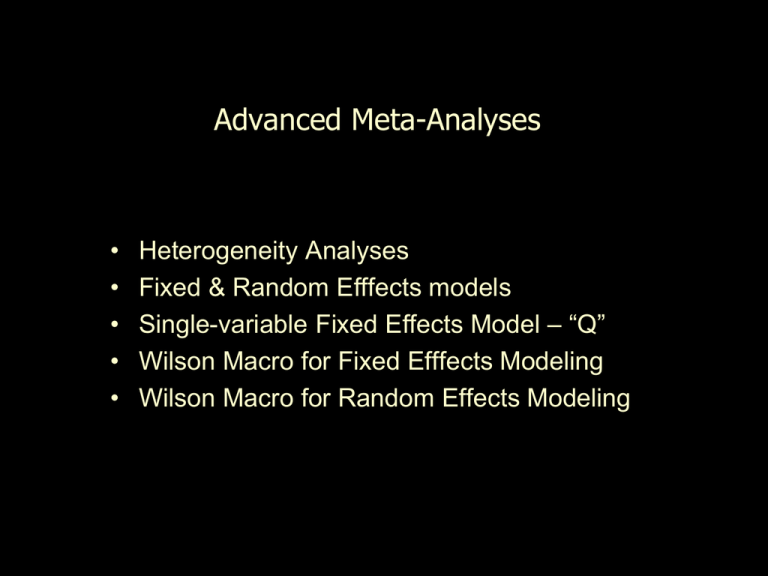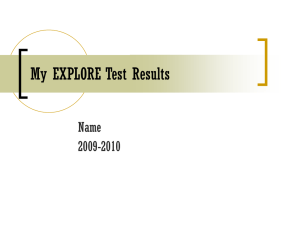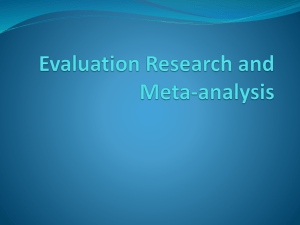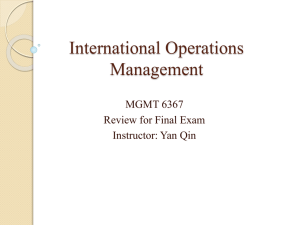Advanced Meta-Analyses Slide Show
advertisement

Advanced Meta-Analyses • • • • • Heterogeneity Analyses Fixed & Random Efffects models Single-variable Fixed Effects Model – “Q” Wilson Macro for Fixed Efffects Modeling Wilson Macro for Random Effects Modeling When we compute the average effect sizes, with significance tests, Cis, etc. -- we assume there is a single population of studies represtented & that all have the same effect size, except for sampling error !!!!! The alternative hypothesis is that there are systematic differences among effect sizes of the studies – these differences are related to (caused by) measurement, procedural and statistical analysis differences among the studies!!! Measurement • operationalizations of IV manipulations/measures & DV measures, reliability & validity, Procedural • sampling, assignment, tasks & stimuli , G/WG designs, exp/nonexp designs, operationalizations of controls Statistical analysis • bivariate v multivariate analyses, statistical control Suggested Data to Code Along with the Effect Size 1. A label or ID so you can backtrack to the exact analysis from the exact study – you will be backtracking!!! 2. Sample size for each group * 3. Sample attributes (mean age, proportion female, etc.) # 4. DV construct & specific operationalization / measure # 5. Point in time (after/during TX) when DV was measured # 6. Reliability & validity of DV measure * 7. Standard deviation of DV measure * 8. Type of statistical test used *# 9. Between group or within-group comparison / design # 10.True, quasi-, or non-experimental design # 11.Details about IV manipulation or measurement # 12.External validity elements (pop, setting, task/stimulus) # 13.“Quality” of the study # – better yet data about attributes used to eval quality!!! We can test if there are effect size differences associated with any of these differences among studies !!! Remember that one goal of meta-analyses is to help us decide how to design and conduct future research. So, knowing what measurement, design, and statistical choices influence resulting effect sizes can be very helpful! This also relates back to External Validity – does the selection of population, setting, task/stimulus & societal temporal “matter” or do basic finding generalize across these? This also related to Internal Validity – does the selection of research design, assignment procedures, and control procedures “matter” or do basic finding generalize across these? Does it matter which effect size you use – or are they generalizable??? This looks at population differences, but any “2nd variable” from a factorial design or multiple regression/ANCOVA might influence the resulting effect size !!! Tx Cx Tx 1st Grade school 2nd Middle School 3rd High School Cx 4th 5th Tx-Cx Main effect Simple Effect of Tx- Cx for Grade school children We can test for homogeneity vs. heterogeneity among the effect sizes in our meta-analysis. The “Q test” has a formulas much like a Sum of Squares, and is distributed as a X2, so it provides a significance test of the Null Hypothesis that the heterogeneity among the effect sizes is no more than would be expected by chance, We already have much of this computed, just one more step… Please note: There is disagreement about the use of this statistical test, especially about whether it is a necessary pre-test before examining design features that may be related to effect sizes. Be sure you know the opinion of “your kind” !!! Computing Q Step 1 You’ll start with the w & s*ES values you computed as part of the mean effect size calculations. Computing Q Step 2 Compute weighted ES2 for each study 1. Label the column 2. Highlight a cell 3. Type “=“ and the formula (will appear in the fx bar above the cells) 4. Copy that cell into other cells in that column Formula is 2 “w” cellref * “ES (Zr)” cellref Computing Q Step 3 Compute sum of weighted ES2 1. Highlight cells containing “w*ES2” values 2. Click the “Σ” 3. Sum of those cells will appear below last cell Computing Q Step 4 Compute Q 1. Add the label 2. Highlight a cell 3. Type “=“ and the formula (will appear in the fx bar above the cells) 2 “sum weightedES” cellref The formula is “sum w*ES^2” cellref - ----------------------------------“sum weights” cellref Computing Q Step 5 Add df & p 1. Add the labels 2. Add in df = #cases - 1 3. Calculate p-value using Chi-square pvalue function Formula is CHIDIST( “Q” cellref , “df” cellref ) p > .05 Interpreting the Q-test • effect size heterogeneity is no more than would be expected by chance • Study attributes can not be systematically related to effect sizes, since there’s no systematic variation among effect sizes p < .05 • Effect size heterogeneity is more than would be expected by chance • Study attributes may be systematically related to effect sizes Keep in mind that not everybody “likes” this test! Why??? • An alternative suggestion is to test theoretically meaningful potential sources of effect size variation without first testing for systematic heterogeneity. • It is possible to retain the null and still find significant relationships between study attributes and effect sizes!! Attributes related to Effect Sizes There are different approaches to testing for relationships between study attributes and effect sizes: Fixed & Random Effects Q-test These are designed to test whether groups of studies that are qualitatively different on some study attribute have different effect sizes Fixed & Random Effects Meta Regression These are designed to examine possible multivariate differences among the set of studies in the meta-analysis, using quantitative, binary, or coded study attribute variables. Fixed Effects Q-test -Comparing Subsets of Studies Step 1 Sort the studies/cases into the subgroups Different studies in this meta-analysis were conducted by teachers of different subjects – Math & Science. Were there different effect sizes from these two classes ?? All the values you computed earlier for each study are still good ! Computing Fixed Effects Q-test Step 2 Compute weighted ES2 for each study 1. Label the column 2. Highlight a cell 3. Type “=“ and the formula (will appear in the fx bar above the cells) 4. Copy that cell into other cells in that column Formula is 2 “w” cellref * “ES (Zr)” cellref Computing Fixed Effects Q-test Step 3 Get sums of weights, weighted ES & weighted ES2 1. Add the “Totals” label 2. Highlight cells containing “w” values 3. Click the “Σ” 4. Sum of those cells will appear below last cell 5. Repeat to get sum of each value for each group Computing Q Step 4 Compute Qwithin for each group 1. Add the label 2. Highlight a cell 3. Type “=“ and the formula (will appear in the fx bar above the cells) 2 “sum weightedES” cellref The formula is “sum w*ES^2” cellref - ----------------------------------“sum weights” cellref Computing Q Step 5 Compute Qbetween 1. Add the label 2. Highlight a cell 3. Type “=“ and the formula (will appear in the fx bar above the cells) The formula is Q – (Qw1 + Qw2) Computing Q Step 6 Add df & p 1. Add the labels 2. Add in df = #cases - 2 3. Calculate p-value using Chi-square p-value function Formula is CHIDIST( “Q” cellref , “df” cellref ) Interpreting the Fixed Effects Q-test p > .05 • This study attribute is not systematically related to effect sizes p < .05 • This study attribute is not systematically related to effect sizes If you have group differences, you’ll want to compute separate effect size aggregates and significance tests for each group. Computing weighted mean ES for @ group Step 1 Compute weighted mean ES 1. Add the label 2. Highlight a cell 3. Type “=“ and the formula (will appear in the fx bar above the cells) The formula is “sum weightedES” cellref ----------------------------------“sum weights” cellref Computing weighted mean r for @ group Step 2 Transform mean ES r 1. Add the label 2. Highlight a cell 3. Type “=“ and the formula (will appear in the fx bar above the cells) The formula is FISHERINV( “meanES” cellref ) Ta Da !!!! Z-tests of mean ES ( also test of r ) Step 1 Compute Standard Error of mean ES 1. Add the label 2. Highlight a cell 3. Type “=“ and the formula (will appear in the fx bar above the cells) The formula is SQRT(1 / “sum of weights” cellref ) Z-test of mean ES ( also test of r ) Step 2 Compute Z 1. Add the label 2. Highlight a cell 3. Type “=“ and the formula (will appear in the fx bar above the cells) The formula is Ta Da !!!! “weighted Mean ES cellref” / “SE mean ES cellref” Random Effect Q-test -- Comparing Subsets of Studies Just as there is the random effects version of the mean ES, there is ransom effects version of the Q-test, Like with the mean ES computation, the difference is the way the error term is calculated – based on the assumption that the variability across studies included in the meta-analysis comes from 2 sources; • Sampling variability • “Real” effect size differences between studies caused by the differences in operationalizations and external validity elements Take a look at the demo of how to do this analysis using the SPSS macros written by David Wilson. Meta Regression Far more interesting than the Q-test for comparing subgroups of studies is meta regression. These analyses allow us to look at how multiple study attributes are related to effect size, and tell us the unique contribution of the different attributes to how those effects sizes vary. There are both “fixed effect” and “random effects” models. Random effects meta regression models are more complicated, but have become increasingly popular because the assumptions of the model include the idea that differences in the effect sizes across studies are based on a combination of sampling variation and differences in how the studies are conducted (measurement, procedural & statistical analysis differences). An example of random effects meta regression using Wilson’s SPSS macros is shown in the accompanying handout.



